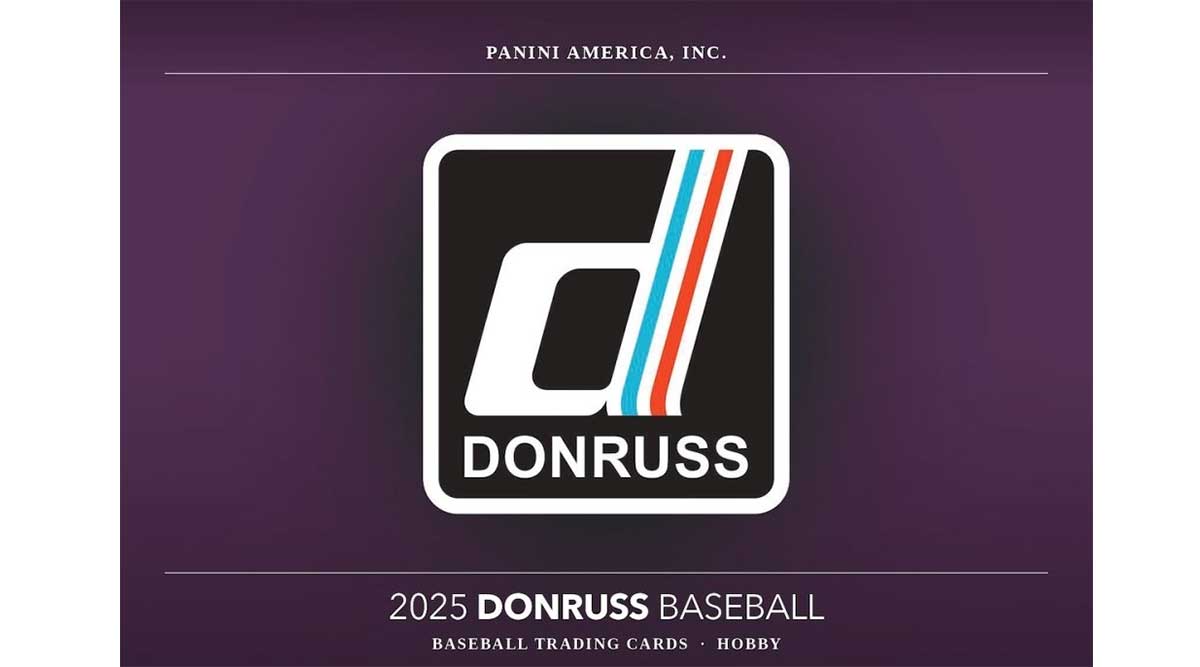
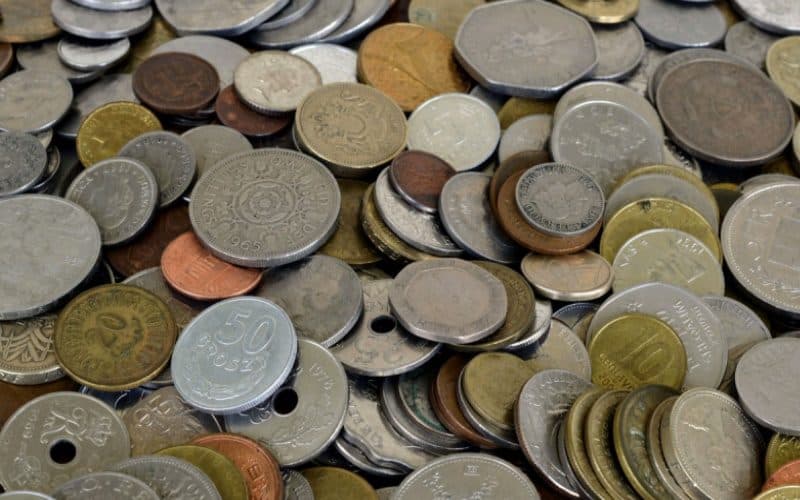
Aptly dubbed the “Hobby of Kings,” coin collecting is one of the oldest recorded hobbies. This practice dates back to ancient civilizations such as the Romans and Greeks, who sought and collected interesting coins from around the world.
In recent years, coin collecting has become a popular hobby, with collectors looking for exciting things to collect. This is also due to the increasing value of some rare and unique coins.
This article shall cover all you need to know about coins and collectibles and how you can start building your collection right away.
While people have hoarded coins since the late seventh century BCE, collecting coins for their artistic value began later. Experts say coin collecting as a hobby date back to ancient Greece.
Rome’s first emperor, Augustus Caesar, is the first known coin collector. He was said to present intricately designed coins to his friends as gifts on special occasions. In ancient Greece, giving people coins as gifts was also customary. People tracked down rare coins to add to their collections.
Tangible archaeological evidence exists that people collected coins from the Roman era. Archaeologists found a cache of over 70 Roman gold coins at Vidy, Switzerland. This hoard dated to the period of Roman rule and didn’t have any two coins of the same type, which implies that the coins were a collector’s hoard.
By the 19th Century, coin collecting had shifted from a hobby for the elites. The first international convention for coin collectors was held in 1962 by the American Numismatic Association and the Royal Canadian Numismatic Association. Its estimated attendance of over 40,000 showed how widespread the hobby had become.
Today, coin collecting as a hobby has become even more widespread. There are coin shows, collectors’ conventions, trade associations, and regulatory bodies to guide the hobby.
While we can’t determine exactly how many people collect coins, the United State Mint estimates that about 120 million Americans pursued the 50 States Quarters issued from 1999 through 2008.
There are several reasons for collecting coins and a few of the most common reasons include:
Coins are great collectibles for people with a thirst for knowledge. Asides from tucking your coin collection away, there are so many interesting things the coins can teach you.
You can learn about the history of a country just by studying its coins. You could also learn a great deal about the period a particular coin was minted or the notable figures depicted on the coins.
There’s the thrill of the chase and the rewarding feeling of accomplishment when you finally complete a set. Coin collecting is a fascinating hobby, as it might take months of searching to find a rare coin to complete an old collection.
While you could get started collecting change, commemorative coins are great to pursue to maximize this feeling of accomplishment.
Several hobbies require a substantial figure to get started. Coin collecting is affordable, and you can get started with zero investments. While collectors have gotten rare coins for as high as $18.9 million, interesting coins are available at low prices. Additionally, you only need a little in terms of supplies to store your coin collections.
One of the reasons people collect coins is because they know they can make a significant profit from their collections. While most people collect coins because of their artistic and historical value, several big money sales have changed how people view coin collecting today.
The investment potential with coin collection is high, and several coins have sold for millions of dollars. The Professional Coin grading Services (PCGS) shows that prices of rare coins have risen 16% from last year. It also shows a 6,315% increase in price since 1970.
In addition to the primary reasons for coin collecting, collectors may start collecting for a variety of other reasons.
You can start collecting immediately if you’re merely intrigued by the intricate design of coins, the beautiful artworks, or learning about the periods when these coins were produced.
You can get started in basic coin collecting by collecting coins in circulating or visiting Amazon or the United States Mint catalog to buy whatever coin appeals to you. However, you need to be more selective if you wish to collect coins to sell them later.
They have produced coins for several centuries, and the range available can be overwhelming. To avoid being overwhelmed, it’s best to specialize in a single category.
The various categories to pick from include:
This is the most common way people begin collecting coins. Simply pick a theme or topic depicted on the coin and build your collections around it. It could be animals, sports, presidents, landmarks, or buildings. Once you’ve decided on a theme, collect coins that align with it and build your collection.
You could also decide to collect coins from a particular period in the past. You could collect WW2 coins, Ancient coins, early colonial coins, or coins with America’s founding fathers. Collectors cherish many coins from these historical periods due to their scarcity and rarity.
Of course, collecting most of these old coins would require a substantial budget to get started. However, they offer the most return on investments when you do decide to sell them.
This is collecting based on the coin’s value, such as ¢, 5¢, 10¢, 25¢, 50¢, and $1. Collecting based on value allows you to explore various designs, types, and mint marks.
This is collecting coins from a particular country/region. Asides from gathering these coins, this is a great way to learn about the history and culture of a country.
While British coins are particularly popular, coins from other countries might offer more excellent value for their historical importance and rarity.
Error coins are coins with some sort of mistake or anomaly usually occurring during the minting process. As with all collectibles, most error coins are valued higher than “regular” coins due to their uniqueness and rarity. Some common errors include:
While errors can increase the value of your coin, not every error coin is worth more than its counterparts. It pays to research and only go after error coins that have proven to hold great value. A few notable error coins are the Three-legged Buffalo Nickel and the 1955 Double Die Lincoln Cent.
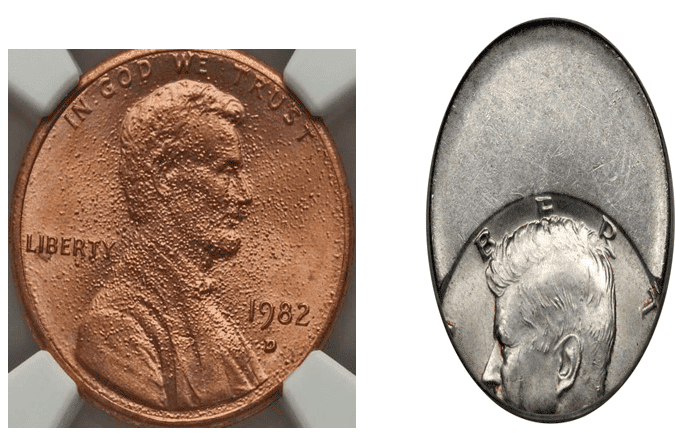
Here, you collect coins made from a specific metal such as gold, silver, or copper. Collecting by composition allows you to explore various designs, periods or denominations.
Once you’ve decided on a category of coins to collect, the next step is buying the coins. The coin-collecting hobby is enormous and there are various websites where you can purchase these coins.
No matter the theme you’re collecting, you will find tons of offers on these websites to grow your collection.
While you could potentially find any coin you’re looking for at these online stores, you’d be hard-pressed to find a good deal.
This is especially true if you’re looking to sell them off later for a profit. Collectors looking to buy coins in bulk might have to look elsewhere for good deals.
These include:
Ensure you do your due diligence when purchasing to avoid buying fake or replicated coins. Most online marketplaces have a refund policy in place to guard against this. However, you need to be extra careful when making purchases from yard sales or the flea market.
When building your initial collection, it’s always a great idea to start small with cheap purchases and gently ease into the hobby. New collectors might feel compelled to start big.
However, starting small gives you enough time to learn the ropes and understand how things work before making any major purchase. Coin collecting is all about patience and slowly building your collection.
Grading is the process of determining the condition of a coin. Grading is a crucial factor in determining a coin’s value. It’s also the biggest area of contention when collecting coins, as a coin’s grade can be open to several interpretations.
This is because coin grading is ultimately an opinion based upon a defined standard that coin collectors agree with.
In the early days, coins generally had just four grades.
However, as coin collecting became a worldwide hobby, a precise grading standard was required. More precise grading systems would allow for more specific pricing, which the booming coin collector market needed. In 1948, numismatist Dr. Williams Herbert Sheldon standardized coin grading by inventing the Sheldon Scale that’s used today.
The Sheldon Scale ranges from a grade of Poor to Perfect Mint. A coin’s grade is assigned based on what it scores on this seventy-point scale. He concluded that an uncirculated coin (MS-70) sold for 70 times the value of a barely identifiable coin (Poor-1).
Shop for coins on eBay
Generally, we determine a coin grade by these criteria: Strike, preservation, luster, and attractiveness. The coin grades are as follows:
| Poor (P-1) | Heavily damaged and barely identifiable. The date and mintmark must be visible. |
| Fair (FR-2) | Worn but less damaged than coins graded poor. Enough details remain to identify the coin. |
| Good (G-4) | Significant features are mostly worn and inscriptions merging into the rims. |
| Fine (F-12) | Evenly worn with all design elements clearly visible. |
| Very Fine (VF-20) | Moderately worn but has all the finer details, such as the motto and writings, clearly visible. |
| Extremely Fine (EF-40) | Lightly worn with all significant details boldly visible |
| About Uncirculated (AU-50) | Slight trace of wear with increased eye appeal and few contact marks. |
| Very Choice About Uncirculated (AU-58) | No contact marks with mere hints of wear marks. Almost full mint luster |
| Mint State Basal (MS-60) | Slightly uncirculated with zero evidence of wear but with noticeable contact marks. |
| Mint State Acceptable (MS-63) | Uncirculated but with nicks and slightly impaired luster. |
| Mint State Choice (MS-65) | Uncirculated with solid mint luster and few contact marks. |
| Mint State Premium Quality (MS-68) | Perfect luster and no visible contact mark to the human eye. Looks sharp and attractive. |
| Mint State Almost Perfect (MS-69) | Uncirculated with perfect luster, stunning strike and excellent eye appeal. Almost perfect but contains tiny contact marks only visible under 8x magnification. |
| Mint State Perfect (MS-70) | Perfect in all ramifications, even under magnification. It contains 0 flaws, is perfectly centered and outstanding. |
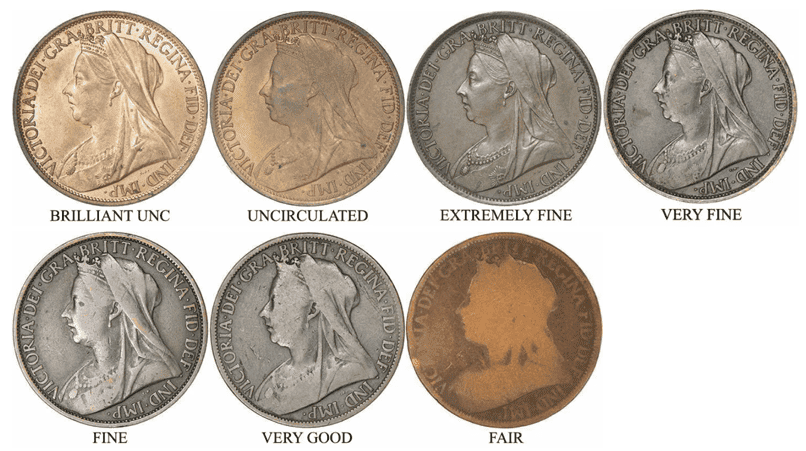
As a coin collector, it’s in your best interest to have basic knowledge of how to grade coins yourself. While there are several professional grading service providers, learning how to grade your coins is imperative for several reasons.
When you know how to grade coins, you can pay for ungraded coins knowing that you’re paying the coin’s worth. Additionally, if you only collect specific grades, you’ll be sure that the coin will fit the scope of your collection.
Knowing how to grade coins yourself is also important when sending your coins to these third-party grading companies. It allows you to submit coins wisely, as you already have an idea of the grade you’ll receive.
To grade coins yourself, you need a few supplies.
Experts recommend a lamp with a 75 or 100-watt bulb placed close to where you’ll be looking at the coin. We recommend a 100-watt bulb or a special high-intensity lamp, as anything less than that will not be bright enough. Avoid fluorescent bulbs and other bulbs that give off a yellowish light.
You need a good magnifying glass to study the coin for damage marks and scratches too tiny for the eye to see. Any magnifying glass with a 3x to 8x magnification would let you view the coin up close and notice all the minute details. Anything stronger than an 8x magnification is usually too strong for coin grading.
Shop for magnifying glass on eBay
You require a reference to look at and determine what grade your coin falls in. Many books, coin guides, websites and communities provide coin grades and pictures for various popular coins. Most of these sources point out specific places to look at to assess signs of damage.
While the process involved in grading your coin yourself is easy on paper, it’ll take practice to become an expert at it.
Learning how to grade your coin takes a great deal of patience and practice to master. You do not need to beat yourself up when you get a grade wrong. Experience is the best teacher; you gain experience with the more coins you grade.
While it’s a great idea to know how to grade coins as a collector, you’ll eventually require the services of professional graders. Once your coins have been professionally graded, you’ll receive a universally accepted certification of your coin’s grade.
Few companies have stood out from the pack as the most credible and trusted source for grading your coins as an investor. These are:
Founded in 1985, the PCGS is a foremost choice for collectors looking to get their coins graded. With over 40 million coins graded, the PCGS is a pioneer in how coins are collected and graded today.

The NGC began offering its services two years after the PCGS in 1987. However, they’ve graded over 50 million coins from all around the world. This dominance in the number of coins graded shows just how popular the NGC is with coin collectors.
The NGC is the official grading service of the ANA (American Numismatic Association) and the Professional Numismatists Guild. NCG offers collectors a more comprehensive range of special options, such as unique slabs and labels.
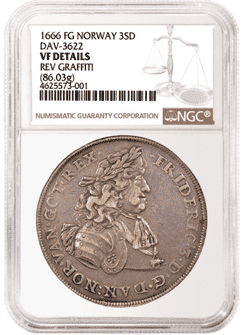
ANACS is America’s oldest coin-grading company. Founded in 1972, its primary purpose was to guard the hobby against fakes flooding the market. At first, ANACS would only certify a coin as authentic and provide a certificate of authenticity. However, as the hobby evolved, they began grading coins in 1979.
Shop for ANACS graded coins on eBay

Any of these third-party grading services are great for collectors looking to get their coins graded. The fee for grading coins and how long it’ll take to get your coin varies for each of them. However, their certification once they grade your coin is globally acceptable.
The fact that coins are made of metal gives most new collectors the false impression that they do not require much in terms of storage. However, the surface of a coin is very delicate and can be easily damaged if not correctly cared for.
The wrong atmosphere alone is enough to damage some metals used in minting the coin. Asides from its aesthetic benefits, learning how to clean and store your coin properly would protect the value of your coins.
There are several ways to store your coins to ensure it maintains their value. For new collectors with lots of low-value coins, you can keep your coins in the following:
Albums, folders, and coin boards are inexpensive ways to store several low-value coins. They are cheap, readily available and offer some protection to your collection.
Albums let you view both sides of the coin, while you can only view one side when using a folder. Since one side of the coin is continually exposed to the elements when using a folder, it runs the risk of toning after a while.
Experts advise putting your coin in an envelope or pocket before storing it in the folder. This prevents the coin from being damaged when you insert or remove it.
Buy coin album on eBay
Buy coin folders on eBay
Buy coin boards on eBay
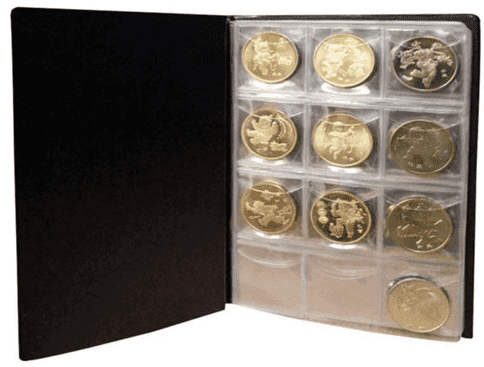
Like envelopes, 2x2s are small cardboard holders with a cellophane window that folds over a coin. Simply fold the 2×2 holder over your coin and use a stapler to hold the sides. There are various sizes of 2×2 holders for the different types of coins.
While a 2×2 might offer some protection, you still need housing if you don’t want your coins lying loosely. You’ll require cardboard boxes to store the coins. There are specially designed boxes meant to hold your coins.
Shop for Coin flips and Coin boxes on eBay
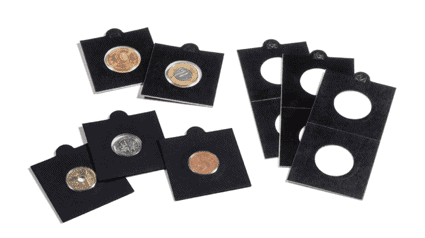
Tubes are clear, archival-quality plastic designed to preserve your coin for long periods. Depending on the size, you can store up to fifty United States pennies in one coin tube. However, tubes are for storing coins of lower value rather than high-value coins.
Whichever enclosure method you store your coins in, ensure the material is acid-free. Avoid plastics made using PVC as it’s generally not acid-free. It’ll eventually break down, becoming acidic. PVC becomes yellow, brittle, and cloudy as it degrades, letting off acids into the storage environment that may leave a green residue on your coins.
If your collection has truly valuable coins, experts suggest investing in plastic holders, PVC-free plastic bags or sealed slabs. Additionally, you’ll need specialized boxes to store your slabbed coins.
While these are quite pricey compared to 2x2s and cardboard boxes, they offer maximum protection to your most prized coins. Most valuable coins and coin set comes with a certificate of authenticity. They should be stored appropriately as well.
Shop for plastic coin holders and coin slabs on eBay
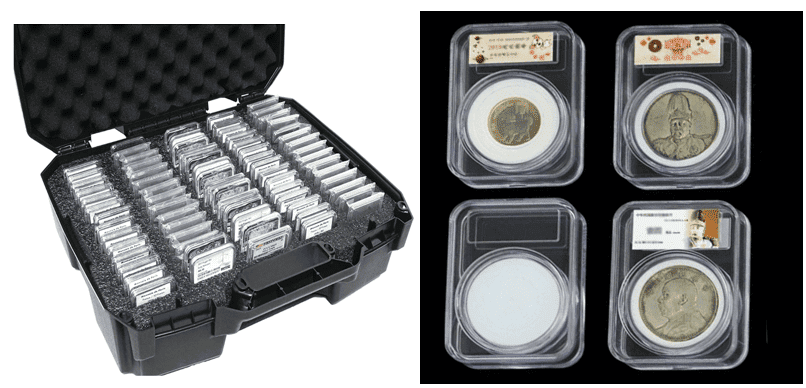
The storage area you choose will influence the condition of your collection and how long it’ll last. The most suitable place to store your collection are:
Every collector has varying thoughts on whether you should clean your coins. While there’s a proper way to clean your coins to prevent them from losing their value, experts advise that you DO NOT clean any rare or high-value coin in your collection. This is because cleaning these coins could potentially devalue them.
However, we shall discuss the right way to clean coins to get rid of all accumulated dirt and grim. Again, you should only clean low-value coins and only when it’s absolutely necessary.
One of the least risky ways to clean your coin is running it under tap water. However, ensure you do not use water that’s hard or corrosive. You could run your coin under distilled water if your house’s water is corrosive.
Fill a container with warm water and add a few drops of mild soap. Immerse the coins and gently rub them with your fingers or a very soft toothbrush. This is perfect for getting rid of accumulated dirt or grime.
Pour vinegar into a glass and then soak your coins in it for anything between 30 minutes – 3 hours. Wipe clean with a cotton towel or scrub gently with a soft toothbrush.
Like vinegar, hydrogen peroxide effectively removes dirt from your coin’s surface. Place your coin in a plastic container and fill it to cover it with hydrogen peroxide. Soak for 24 hours and rinse off with water.
Listerine and other antiseptic mouthwashes are great for safely cleaning your coins. Simply soak your coin in mouthwash for 12 hours, then remove and rinse off with water.
This is great for removing corrosion from coins. However, it’s a delicate and risky process and should not be used with rare coins. Wet the coin with distilled water and roll it in baking soda to clean the corrosion off an old coin. Gently scrub the coin with a soft toothbrush and rinse the debris off with clean water.
Cleaning rare and high-value coins is a delicate process and should be left to the professionals. It requires a gentle touch and highly specialized materials to avoid damaging your coin. Collectors that collect these rare high-value old coins prefer corroded coins to coins that have been cleaned.
Building a solid coin collection that will return ample ROI over time isn’t a race. Collectors who hurriedly make purchases to have a large collection almost always end up ruing their decision.
Take the time to be particular about what coins you collect and only make purchases that fit into that category. As with most things in life, it’s quality over quantity.
A handful of precious coins is better than having a basement full of worthless coins. Whether you’re collecting coins as a hobby or an investment, this guide will set you up to do so correctly.
2025 Topps All Star Game Mega Box Product Review
Ripping the new Topps All Star Game mega box.
Is this new sports card store the BEST VALUE around?
I Tested eBay Auction Promotions So You Don’t Have To!
I deep-dove on Fanatics Collect so you don't have to (but should you?)
Panini is launching a WNBA Product at $30,000!?
Topps Chrome 2024-25 Basketball: Honest Review and Notes
Did you know this SECRET about PSA slabs? #sportscard #tcg
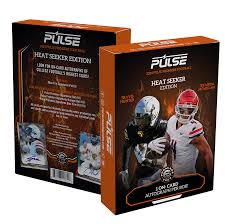
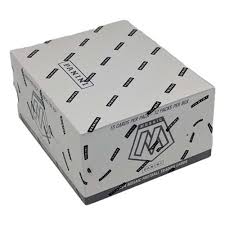

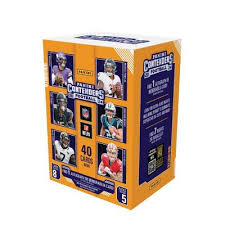
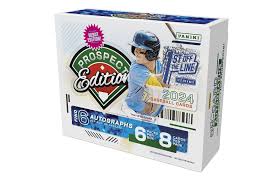
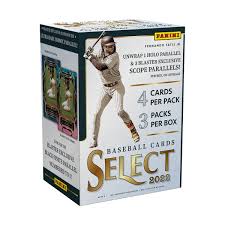
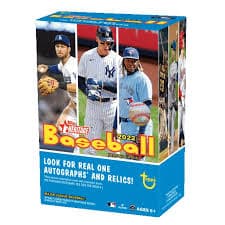
2022 Topps Heritage Baseball Blaster Box Configuration: 7 Packs per Box – 9 Cards per Box. Plus 1 extra pack.
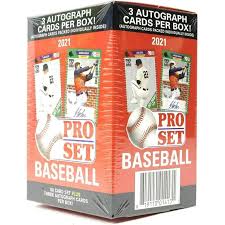
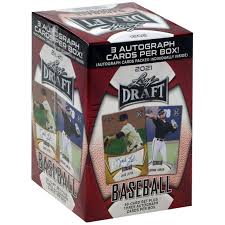
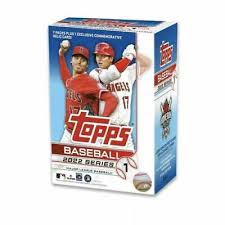
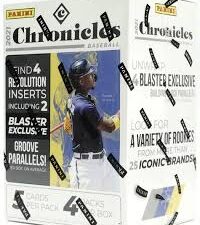
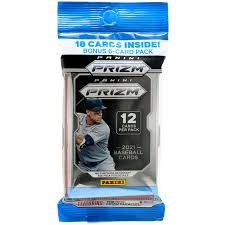
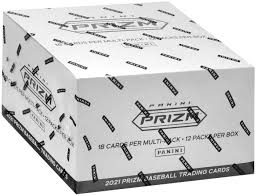

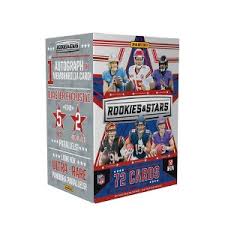
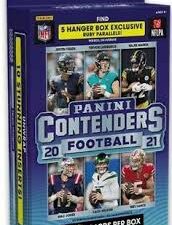
Keep up on breaking Sports Card News, our latest articles, product specials and exclusive content with expert analysis of hobby trends.

© Copyright 2025 - All rights reserved Cardlines.com / Media Techs LLC - Sports Card News, Reviews, Releases and BREAKS - #thehobby.
Important: When you click on links to various merchants on this site and make a purchase, this can result in this site earning a commission. Affiliate programs and affiliations include, but are not limited to, the eBay Partner Network.
The Ultimate 2024 Football Card Brand Tier List (Panini vs. Topps and more!)
Cardlines 22 hours ago